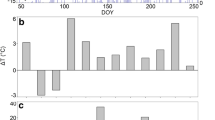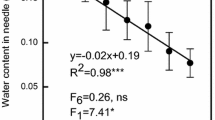Abstract
The long-term impact of elevated CO2 concentration on photosynthetic activity of sun-exposed (E) versus shaded (S) foliage was investigated in a Picea abies stand (age 12 years) after three years of cultivation in adjustable-lamella-domes (ALD). One ALD is supplied with either ambient air [ca. 350 µmol(CO2) mol−1; AC-variant) and the second with elevated CO2 concentration [ambient plus 350 µmol(CO2) mol−1; EC-variant). The pronounced vertical profile of the photosynthetically active radiation (PAR) led to the typical differentiation of the photosynthetic apparatus between the S- and E-needles in the AC-variant estimated from the irradiance-responses of various parameters of the room temperature chlorophyll (Chl) a fluorescence parameters. Namely, electron transport rate (ETR), photochemical efficiency of photosystem 2, PS2 (ΦPS2), irradiance-saturated values of non-photochemical quenching of minimum (SV0) and maximum (NPQ) fluorescence levels, and photochemical fluorescence quenching (qp) at higher irradiances were all significantly higher for E-needles as compared with the S-ones. The prolonged exposure to EC did not cause any stimulation of ETR for the E-needles but a strongly positive effect of EC on ETR was observed for the S-needles resulting in more than doubled ETR capacity in comparison with S-needles from the AC-variant. For the E-needles in EC-variant a slightly steeper reduction of the ΦPS2 and qp occurred with the increasing irradiance as compared to the E-needles of AC-variant. On the contrary, the S-needles in EC variant revealed a significantly greater capacity to maintain a high ΦPS2 at irradiances lower than 200 µmol m−2 s−1 and to prevent the over-reduction of the PS2 reaction centres. Moreover, compared to the AC-variant the relation between SV0 and NPQ exhibited a strong decrease (up to 72 %) of the SV0-NPQ slope for the E-needles and an increase (up to 76 %) of this value for the S-needles. Hence the E- and S-foliage responded differently to the long-term impact of EC. Moreover, this exposure was responsible for the smoothing of the PAR utilisation vertical gradient in PS2 photochemical and non-photochemical reactions within the canopy.
Similar content being viewed by others
References
Adams, W.W., III, Demmig-Adams, B., Winter, K.: Relative contributions of zeaxanthin-related and zeaxanthin-unrelated types of “high-energy-state” quenching of chlorophyll fluorescence in spinach leaves exposed to various environmental conditions.-Plant Physiol. 92: 302-309, 1990.
Bilger, W., Schreiber, U.: Energy-dependent quenching of dark-level chlorophyll fluorescence in intact leaves.-Photosynth. Res. 10: 303-308, 1986.
Bornman, J.F.: Target sites of UV-B radiation in photosynthesis of higher plants.-J. Photochem. Photobiol. B 4: 145-158, 1989.
Brugnoli, E., Scartazza, A., De Tullio, M.C., Monteverdi, M.C., Lauteri, M., Augusti, A.: Zeaxanthin and non-photochemical quenching in sun and shade leaves of C3 and C4 plant.-Physiol. Plant. 104: 727-734, 1998.
Čajánek, M., Hudcová, M., Kalina, J., Lachetová, I., Špunda, V.: Gradual disassembly of photosystem 2 in vivo induced by excess irradiance. A hypothesis based on changes in 77 K fluorescence spectra of chlorophyll a in barley leaves.-Photosynthetica 37: 295-306, 1999.
DeLucia, E.H., Sasek, T.W., Strain, B.R.: Photosynthetic inhibition after long-term exposure to elevated levels of atmospheric carbon dioxide.-Photosynth. Res. 7: 175-184, 1985.
Demmig, B., Winter, K.: Light response of CO2 assimilation, reduction state of Q and radiationless energy dissipation in intact leaves.-Aust. J. Plant Physiol. 15: 151-162, 1988.
Demmig-Adams, B.: Survey of thermal energy dissipation and pigment composition in sun and shade leaves.-Plant Cell Physiol. 39: 474-482, 1998.
Demmig-Adams, B., Adams, W.W., III: Capacity for energy dissipation in the pigment bed in leaves with different xanthophyll cycle pools.-Aust. J. Plant Physiol. 21: 575-588, 1994.
Demmig-Adams, B., Adams, W.W., III: Xanthophyll cycle and light stress in nature: uniform response to excess direct sunlight among higher plant species.-Planta 198: 460-470, 1996.
Demmig-Adams, B., Adams, W.W., III, Barker, D.H., Logan, B.A., Bowling, D.R., Verhoeven, A.S.: Using chlorophyll fluorescence to assess the fraction of absorbed light allocated to thermal dissipation of excess excitation.-Physiol. Plant. 98: 253-264, 1996.
Denning, A.S., Fung, I.Y., Randall, D.: Latitudinal gradient of atmospheric CO2 due to seasonal change with land biota.-Nature 376: 240-246, 1995.
Färber, A., Young, A.J., Ruban, A.V., Horton, P., Jahns, P.: Dynamics of xanthophyll-cycle activity in different antenna subcomplexes in the photosynthetic membranes of higher plants. The relationship between zeaxanthin conversion and nonphotochemical fluorescence quenching.-Plant Physiol. 115: 1609-1618, 1997.
Genty, B., Briantais, J.-M., Baker, N.R.: The relationship between the quantum yield of photosynthetic electron transport and quenching of chlorophyll fluorescence.-Biochim. biophys. Acta. 990: 87-92, 1989.
Gilmore, A.M., Hazlett, T.L., Govindjee: Xanthophyll cycle-dependent quenching of photosystem II chlorophyll a fluorescence: formation of a quenching complex with a short fluorescence time.-Proc. nat. Acad. Sci. USA 92: 2273-2277, 1995.
Härtel, H., Lokstein, H.: Relationship between quenching of maximum and dark-level fluorescence in vivo: dependence on Photosystem II antenna size.-Biochim. biophys. Acta 1128: 91-94, 1995.
Kalina, J., Čajánek, M., Kurasová, I., Špunda, V., Vrána, J., Marek, M.V.: Acclimation of photosystem 2 function of Norway spruce induced during first season under elevated CO2 in lamellar domes.-Photosynthetica 38: 621-627, 2000.
Kalina, J., Čajánek, M., Špunda, V., Marek, M.V.: Changes of the primary photosynthetic reactions of Norway spruce under elevated CO2.-In: Mohren, G.M.J., Kramer, K., Sabaté, S. (ed.): Impacts of Global Change on Tree Physiology and Forest Ecosystems, Pp. 59-66. Kluwer Acad. Publ., Dordrecht-Boston-London 1997.
Koch, K.E.: Carbohydrate-modulated gene expression in plants.-Annu. Rev. Plant Physiol. Plant mol. Biol. 47: 509-540, 1996.
Kramer, P.J.: Carbon dioxide concentration, photosynthesis, and dry matter production.-BioScience 31: 29-33, 1981.
Larkum, A.W.D., Wood, W.F.: The effect of UV-B radiation on photosynthesis and respiration of phytoplankton, benthic macroalgae and seagrasses.-Photosynth. Res. 36: 17-23, 1993.
Lawlor, D.W., Mitchell, R.A.C.: The effects of increasing CO2 on crop photosynthesis and productivity: a review of field studies.-Plant Cell Environ. 14: 807-818, 1991.
Logan, B.A., Demmig-Adams, B., Adams, W.W., III, Grace, S.C.: Antioxidants and xanthophyll cycle-dependent energy dissipation in Cucurbita pepo L. and Vinca minor L. acclimated to four growth PPFDs in the field.-J. exp. Bot. 49: 1869-1879, 1998.
Long, S.P., Drake, B.G.: Photosynthetic CO2 assimilation and rising atmospheric CO2 concentration.-In: Baker, N.R., Thomas, H. (ed.): Crop Photosynthesis: Spatial and Temporal Determinants. Pp. 69-103. Elsevier Science Publ., The Hague 1992.
Marek, M.V., Pokorný, R., Šprtová, M.: An evaluation of the physiological and growth activity of Norway spruce saplings after planting.-J. Forest Sci. 46: 91-96, 2000.
Marek, M.V., Šprtová, M., Kalina, J.: The photosynthesis irradiance-response of Norway spruce exposed to a long-term elevation of CO2 concentration.-Photosynthetica 33: 259-268, 1997.
Norby, R.J., Wullschleger, S.D., Gunderson, C.A., Johnson, D.W., Ceulemans, R.: Tree responses to rising CO2 in field experiments: implications for the future forest.-Plant Cell Environ. 22: 683-714, 1999.
Pammenter, N.W., Loreto, F., Sharkey, T.D.: End product feedback effects on photosynthetic electron transport.-Photosynth. Res. 35: 5-14, 1993.
Ruban, A.V., Young, A., Horton, P.: Modulation of chlorophyll fluorescence quenching in isolated light harvesting complex of Photosystem II.-Biochim. biophys. Acta 1186: 123-127, 1994.
Sage, R.F., Reid, C.D.: Photosynthetic response mechanisms to environmental change in C3 plants.-In: Wilkinson, R.E. (ed.): Plant-Environment Interactions. Pp. 413-499. Marcel Dekker, New York-Basel-Hong Kong 1994.
Sage, R.F., Sharkey, T.D., Seemann, J.R.: Acclimation of photosynthesis to elevated CO2 in five C3 species.-Plant Physiol. 89: 590-596, 1989.
Špunda, V., Čajánek, M., Kalina, J., Lachetová, I., Šprtová, M., Marek, M.V.: Mechanistic differences in utilization of absorbed excitation energy within photosynthetic apparatus of Norway spruce induced by the vertical distribution of photosynthetically active radiation through the tree crown.-Plant Sci. 133: 155-165, 1998.
Stitt, M.: Rising CO2 levels and their potential significance for carbon flow in photosynthetic cells.-Plant Cell Environ. 14: 741-762, 1991.
Stitt, M.: Enhanced CO2, photosynthesis and growth: what should we measure to gain a better understanding of the plant's response?-In: Schulze, E.D., Mooney, H.A. (ed.): Design and Execution of Experiments on CO2 Enrichment. Pp. 3-28. Commission of European Communities, Brussels 1993.
Urban, O., Janouš, D., Pokorný, R., Marková, I., Pavelka, M., Fojtík, Z., Šprtová, M., Kalina, J., Marek, M.V.: Glass domes with adjustable windows: A novel technique for exposing juvenile forest stands to elevated CO2 concentration.-Photosynthetica 39: 395-401, 2001.
Wolfe, D.W., Gifford, R.M., Hilbert, D., Luo, Y.: Integration of photosynthetic acclimation to CO2 at the whole-plant level.-Global Change Biol. 4: 879-893, 1998.
Woodman, J.N.: Variation of net photosynthesis within the crown of a large forest-grown conifer.-Photosynthetica 5: 50-54, 1971.
Würth, M.K.R., Winter, K., Körner, C.: In situ responses to elevated CO2 in tropical forest understory plants.-Funct. Ecol. 12: 886-895, 1998.
Zhang, H.H., Sharifi, M.R., Nobel, P.S.: Photosynthetic characteristics of sun versus shade plants of Encelia farinosa as affected by photosynthetic photon flux density, intercellular CO2 concentration, leaf water potential, and leaf temperature.-Aust. J. Plant Physiol. 22: 833-841, 1995.
Author information
Authors and Affiliations
Rights and permissions
About this article
Cite this article
Marek, M., Šprtová, M., Urban, O. et al. Chlorophyll a Fluorescence Response of Norway Spruce Needles to the Long-Term Effect of Elevated CO2 in Relation to Their Position Within the Canopy. Photosynthetica 39, 437–445 (2001). https://doi.org/10.1023/A:1015146830318
Issue Date:
DOI: https://doi.org/10.1023/A:1015146830318




